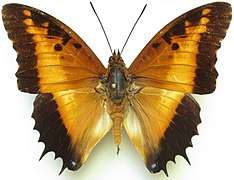Charaxes pollux
Charaxes pollux, the black-bordered charaxes, is a butterfly in the family Nymphalidae.
| Charaxes pollux | |
|---|---|
| Charaxes pollux, underwings | |
| Scientific classification | |
| Kingdom: | Animalia |
| Phylum: | Arthropoda |
| Class: | Insecta |
| Order: | Lepidoptera |
| Family: | Nymphalidae |
| Genus: | Charaxes |
| Species: | C. pollux |
| Binomial name | |
| Charaxes pollux | |
| Synonyms | |
| |
Taxonomy
The members of the Charaxes jasius group are:
- Charaxes jasius
- Charaxes pelias – smaller than jasius
- Charaxes hansali
- Charaxes castor
- Charaxes brutus – dark with white bands
- Charaxes andara – Madagascar
- Charaxes ansorgei
- Charaxes phoebus
- Charaxes pollux
- Charaxes druceanus
- Charaxes phraortes – Madagascar, close to next
- Charaxes andranodorus – close to last
- Charaxes eudoxus
- Charaxes richelmanni
Subspecies
Subspecies include:[1]
- C. p. pollux (Guinea, Sierra Leone, Liberia, Ivory Coast, Ghana, Nigeria, Cameroon, Central African Republic, Gabon, northern Angola, Congo, Democratic Republic of the Congo, northern and north-western Zambia, Rwanda, Burundi, southern Sudan, Uganda, western and central Kenya, western Tanzania)
- C. p. annamariae Turlin, 1998 (Bioko)
- C. p. gazanus van Someren, 1967 (Mozambique: west to area between the Zambezi and Limpopo Rivers), eastern Zimbabwe)
- C. p. geminus Rothschild, 1900 (Malawi, Zambia: east of the Luangwa Valley), southern and eastern Tanzania, south-eastern Kenya)
- C. p. maua van Someren, 1967 (northern Tanzania)
- C. p. mira Ackery, 1995 (north-eastern Tanzania)
- C. p. piersoni Collins, 1990 (Zanzibar)
Distribution and habitat
Thes species can be found in Guinea, Sierra Leone, Liberia, Ivory Coast, Ghana, Nigeria, Cameroon, Equatorial Guinea, the Central African Republic, Gabon, Angola, the Republic of the Congo, the Democratic Republic of the Congo, Zambia, Rwanda, Burundi, Sudan, Uganda, Kenya, Tanzania, Malawi, Mozambique and Zimbabwe.[1][2] The habitat consists of forests, gallery forests and heavy woodland.
Description
In Charaxes pollux forewings can reach a length of 36–45 millimetres (1.4–1.8 in) in males, of 41–51 millimetres (1.6–2.0 in) in females. The upperside of the forewings is tawny in the basal area, with a broad ochraceous orange post-discal band and a black wide border. The upperside of the hindwings is rather similar, but it has a whitish discal area and pale blue submarginal spots. The underside is red-chestnut, with a white discal band and a series of black bars bordered with white. The edge of the wings is sharply dentate.[3]
Biology
Both sexes are attracted to fermenting fruit and sucking-trees. Adults are probably on wing year round. The larvae feed on Sorindeia species, Bersama abyssinica, Deinbollia kilimandsharica, Deinbollia borbonica, Fluggia microcarpa, Securinega virosa and Fluggia virosa.[1]
Gallery
 C. p. pollux from the CAR - upperside
C. p. pollux from the CAR - upperside C. p. pollux from the CAR - underside
C. p. pollux from the CAR - underside- Illustration from Fauna Africana (1910)
References
| Wikimedia Commons has media related to Charaxes pollux. |
| Wikispecies has information related to Charaxes pollux |
- "Charaxes Ochsenheimer, 1816" at Markku Savela's Lepidoptera and Some Other Life Forms
- Afrotropical Butterflies: File H - Charaxinae - Tribe Charaxini
- Novitates Zoologicae
External links
- Images of C. p. gazanus Royal Museum for Central Africa (Albertine Rift Project)
- Images of C. p. maua (Albertine Rift Project)
- Images of C. p. mira (Albertine Rift Project)
- Images of C. p. piersoni (Albertine Rift Project)
- Images of C. p. pollux (Albertine Rift Project)
- C. p. pollux images at Consortium for the Barcode of Life
- C. p. annamariae images at BOLD
- C. p. geminus images at BOLD
- C. p. gazanus images at BOLD
- C. p. gemius images at BOLD
- C. p. maua images at BOLD
- C. p. piersoni images at BOLD